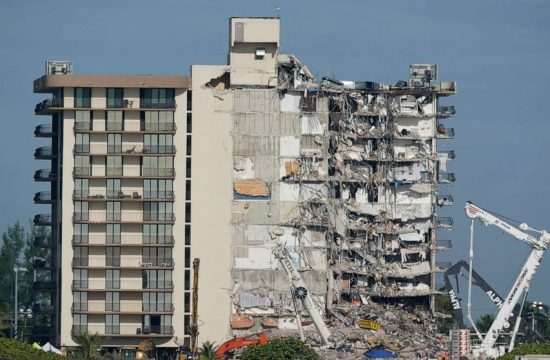MOSCOW —
Public data released this week suggests that Russia‘s national death toll from the coronavirus could be substantially higher than the country’s official count.
Moscow’s city government on Sunday published so-called “all-cause mortality” data for April, which is the total deaths registered in the city from any cause during that period.
Analyzing that data shows that Moscow registered over 1,700 more deaths during April than the average for that month in the previous five years.
That number is considerably more than the 639 deaths reported by Moscow in its official COVID-19 death toll for April, suggesting deaths from coronavirus may be significantly under-counted nationally.
Tune into ABC at 1 p.m. ET and ABC News Live at 4 p.m. ET every weekday for special coverage of the novel coronavirus with the full ABC News team, including the latest news, context and analysis.
However, the same data also suggests that Russia’s real death toll from the virus may be still relatively low, particularly when compared with other countries with similarly large epidemics.
The data is seen as potentially offering an explanation for a riddle that puzzled experts, that is, why does Russia, despite now having the world’s second-largest number of confirmed coronavirus cases, have one of the lowest death rates — 2,418 among 262,843 confirmed cases.
Experts around the world believe that looking at total mortality data in countries during the pandemic offers the best picture of the coronavirus’ real toll, given the wildly differing methods of counting virus deaths from country to country.
By comparing total deaths during the pandemic with those from the same period from previous years, researchers can see if there is a general increase that might represent deaths from the virus. The Financial Times has been gathering all-cause mortality data from countries and found that in virtually all countries badly hit by the virus, the number of so-called “excess deaths” were substantially higher than the official coronavirus counts. Not all excess deaths will be from coronavirus, but experts believe during lockdown other causes such as traffic and work-related accidents will fall. While imperfect, many statisticians believe the approach is the most effective for assessing the real toll of COVID-19.
With the release of Moscow’s data, it has been possible to apply the analysis to Russia for the first time. Other regions, except for St. Petersburg, have not yet made their data for April available. St. Petersburg, which officially had just 29 coronavirus deaths in April, also saw around 200 more deaths than the five-year average, against only 29 coronavirus deaths reported by the city for April.
Russia has denied it is concealing death tolls. Its foreign ministry on Wednesday said it was sending letters to The Financial Times and The New York Times, which first published analysis based on the data, demanding they print retractions. A lawmaker in Russia’s parliament said the ministry should consider expelling the two papers’ journalists.
“We never manipulate state statistics,” Russia’s health minister Tatiana Golikova told reporters when asked about The Financial Times report.
Moscow’s health department released a lengthy statement denying that the “all-cause mortality” data showed its death toll was too low. But in the denial, it acknowledged it was not including more than 60% of deaths of coronavirus patients in Moscow because autopsies showed they had died from other conditions.
If those cases were added to Moscow’s 639 deaths, that would mean 1,598 confirmed coronavirus patients died in the city in April, which would be close to the 1,700 “excess deaths” recorded.
Among the “alternative causes” listed by the health department were heart attacks and renal failure, both conditions often viewed in other countries as the final cause of death, triggered by COVID-19. New York, for example, saw an extraordinary surge of cardiac arrest emergency calls during the early phase of the epidemic which medical experts attribute to the virus.
Countries have different approaches to counting coronavirus deaths and experts believe the true number of virus deaths are significantly underestimated, including in the U.S.
There is little consensus yet among countries on to what extent suspected coronavirus cases should be included among the death toll.
Belgium, for example, has taken the most expansive approach by including all suspected cases and as a result, has had one of Europe’s highest mortality rates. The U.K. only includes patients who died in hospitals and tested positive for the virus.
Russia’s health ministry has taken a very narrow view of what constitutes a COVID-19 death. It includes only those deaths determined by doctors as directly caused by COVID-19 or complications from it, usually pneumonia.
“We, of course, understand that any pandemic influences citizens’ death rates, and it is quite clear, because the virus hits the most sensitive spots, all chronic diseases are aggravated. But it’s just not possible to say in this case that the cause of death was COVID,” Anastasia Rakova, Moscow’s deputy mayor for social development told reporters on Monday.
Russian medical staff told ABC News and other media outlets that other causes are being recorded on death certificates for patients who should have been considered COVID-19 victims, including pneumonia. Frequently, death certificates will list the failure of a specific organ or an underlying chronic illness like cancer, instead.
The narrow criteria facilitates a practice already widespread in Russia even before the pandemic, experts said. Russian demographers dealing in death statistics recall similar practices in the early 2010s, after President Vladimir Putin decreed heart disease numbers should fall.
The irony, one demographic researcher in Moscow said, was that even with the all-cause mortality data added, Russia’s numbers look relatively good compared to many other capital cities.
Moscow’s increase in total deaths in April this year was 17%, around 1,700 more. New York saw 24,200 excess deaths between March 11 and May 9, a jump of 277%, according to The New York Times. The U.K. recorded 15,600 more deaths between March and April, a surge of 37%, according to The Financial Times, and in the Netherlands 6,200 more, a 42% increase.
“Even if the true figures were rolled out it would show that it’s not so bad in Moscow like in other big cities, so I think it’s nothing to be ashamed of,” the researcher, who has experience working with government statistics and has been tracking the new data, said. He requested anonymity because he was not authorized to speak publicly.
Doctors have suggested that the delay in the epidemic’s arrival in Russia gave Moscow more time to prepare its health system. The country also has a far lower life expectancy than western European nations, meaning there are fewer people over 70, who are most vulnerable to coronavirus infection.











